The automated machine learning (Auto ML) market is expanding rapidly, propelled by the growing demand for efficient AI model development and reduced dependency on specialized data science expertise. Auto ML platforms enable organizations to automate model selection, training, and optimization, thereby accelerating the deployment of AI-driven insights.
Market growth is supported by increasing data generation across industries and the need for scalable analytical solutions to manage complex datasets. Cloud-based platforms and open-source frameworks have enhanced accessibility, making Auto ML a key enabler of enterprise digital transformation.
Businesses across sectors such as BFSI, healthcare, and retail are leveraging Auto ML to improve predictive accuracy and operational efficiency. As AI integration becomes a strategic priority, the market is projected to experience significant expansion, driven by advancements in natural language processing, computer vision, and edge computing capabilities.
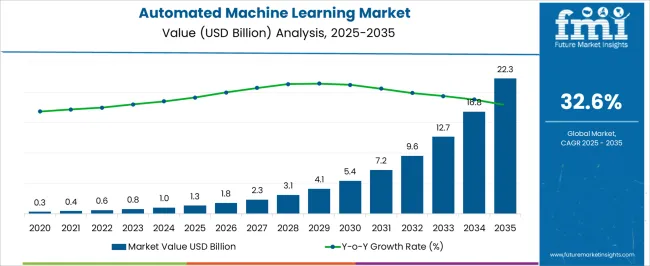
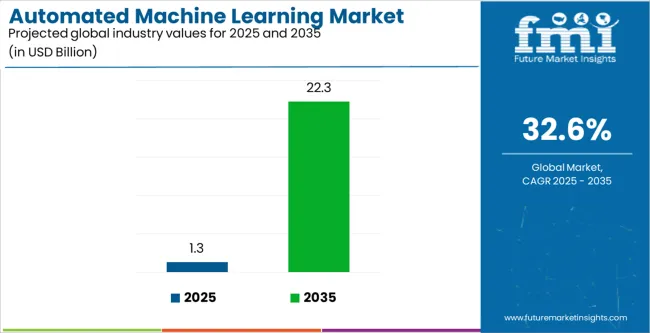
| Metric | Value |
|---|---|
| Automated Machine Learning Market Estimated Value in (2025 E) | USD 1.3 billion |
| Automated Machine Learning Market Forecast Value in (2035 F) | USD 22.3 billion |
| Forecast CAGR (2025 to 2035) | 32.6% |
The market is segmented by Solution, Automation Type, and End User and region. By Solution, the market is divided into Standalone and On-Premises. In terms of Automation Type, the market is classified into Feature Engineering, Data Processing, Data Modelling, Visualization, and Others. Based on End User, the market is segmented into BFSI, Retail And E-Commerce, Healthcare, Manufacturing, and Others. Regionally, the market is classified into North America, Latin America, Western Europe, Eastern Europe, Balkan & Baltic Countries, Russia & Belarus, Central Asia, East Asia, South Asia & Pacific, and the Middle East & Africa.
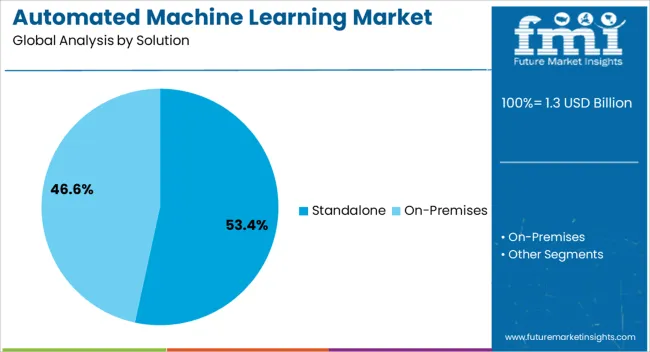
The standalone segment leads the solution category, accounting for approximately 53.40% share. This segment’s growth is driven by enterprises seeking dedicated AutoML platforms that operate independently from broader analytics ecosystems.
Standalone solutions provide greater control over data governance, customization, and integration flexibility. The segment benefits from demand among large organizations with in-house data science teams aiming to accelerate AI deployment cycles.
Continuous improvements in algorithm automation, visualization tools, and interoperability with existing infrastructure have reinforced its adoption. As businesses prioritize scalable, high-performance model development, the standalone segment is expected to maintain a strong presence throughout the forecast period.
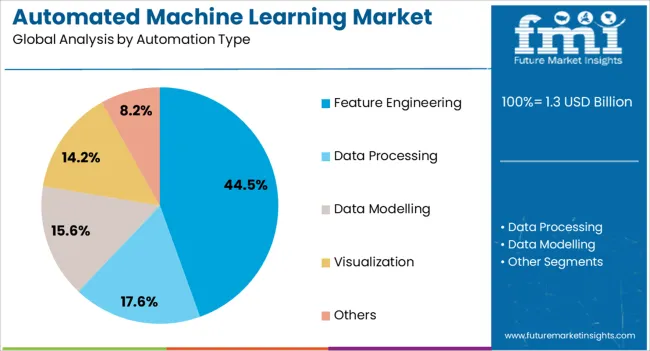
The feature engineering segment dominates the automation type category with approximately 44.50% share. This leadership is attributed to its crucial role in optimizing model performance through automated feature selection, extraction, and transformation.
By minimizing manual preprocessing efforts, AutoML solutions in this segment significantly reduce development time and enhance predictive accuracy. The segment benefits from its application across industries where data complexity is high, including finance, healthcare, and manufacturing.
Advancements in AI-driven data wrangling and representation learning continue to expand its capabilities. With enterprises emphasizing model interpretability and efficiency, feature engineering automation is projected to remain a critical component of AutoML systems.
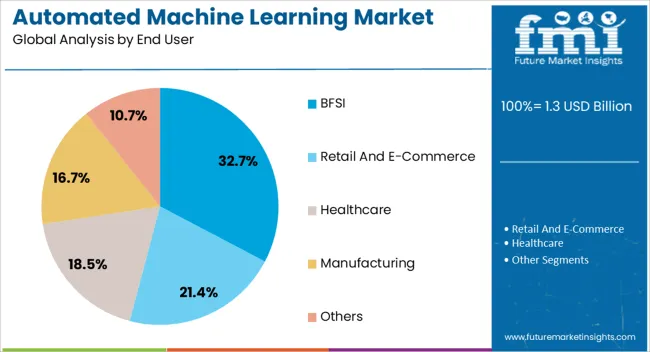
The BFSI segment holds approximately 32.70% share of the end-user category, underscoring its pivotal role in driving AutoML adoption. Financial institutions are deploying automated machine learning to enhance fraud detection, credit risk assessment, and customer analytics.
The need for data-driven decision-making and regulatory compliance has further accelerated usage. AutoML enables BFSI enterprises to process vast datasets efficiently, improving forecasting accuracy and operational agility.
Integration with cloud platforms has enhanced scalability and reduced implementation complexity. With continuous digital transformation initiatives and growing reliance on predictive intelligence, the BFSI segment is anticipated to remain a major contributor to the AutoML market’s growth trajectory.
The global demand for automated machine learning market was estimated to reach a valuation of USD 0.3 billion in 2020, according to a report from Future Market Insights (FMI). From 2020 to 2025, sales witnessed significant growth in the automated machine learning market, registering a CAGR of 48.2%.
| Historical CAGR from 2020 to 2025 | 48.2% |
|---|---|
| Forecast CAGR from 2025 to 2035 | 44.9% |
A driving factor is the growing intricacy of datasets, which calls for sophisticated analytics methods. Organizations may effectively extract important insights by using automated machine learning to handle a variety of data types, including unstructured, semi-structured, and structured data. This expertise is essential for being competitive in data-rich contexts across sectors.
Some important factors that will boost the market growth through 2035 are:
Shortage of Skilled Data Scientists to Push Companies towards Automated Machine Learning
The need to address the scarcity of qualified data scientists as well as machine learning specialists is a significant factor driving the market for automated machine learning. With the exponential expansion of data, the need for data-driven insights is outpacing the availability of expertise to meet that demand.
Automated machine learning platforms democratize AI by allowing non-experts to successfully design and deploy machine learning models. These platforms enable organizations to exploit AI technology without depending only on expensive and limited knowledge by automating repetitive jobs and simplifying complicated procedures. This accelerates the adoption of machine learning across multiple sectors.
The growing need for data-driven decision-making across sectors is one of the factors driving the market for automated machine learning. Automated machine learning streamlines the model development process, which helps firms get useful insights from large datasets.
Organizations may gain a competitive advantage and accelerate the deployment of machine learning models by automating processes like feature engineering, data preparation, and model selection. The increased understanding of AI's ability to promote innovation and improve operational efficiency is another factor driving this need.
Data Privacy and Decoding Complicated Data to Impede Market Growth
The market for automated machine learning is constrained by issues with data privacy, the difficulty of interpreting complicated models, and the lack of qualified workers who can use AI technology efficiently. Widespread adoption is further hampered by difficulties integrating automated machine learning into current workflows and the requirement for open regulatory frameworks.
To fully realize the potential of automated machine learning across companies, overcoming these obstacles will require resolving ethical issues, improving model interpretability, and funding educational and training programs.
This section focuses on providing detailed analysis of two particular market segments for automated machine learning, the dominant solution type and the significant automation type. The two main segments discussed below are standalone solution and feature engineering type.
| Solution Type | Standalone |
|---|---|
| CAGR from 2025 to 2035 | 44.7% |
During the forecast period, the standalone segment is likely to garner a 44.7% CAGR. Standalone automated machine learning will gain popularity as firms seek simplified AI solutions that do not require large infrastructure. With their intuitive interfaces and comprehensive automation, these stand-alone systems let companies quickly implement machine learning models with no technical knowledge.
These technologies, which emphasize the democratization of AI, enable users from all industries to take use of sophisticated analytics, promoting efficiency and creativity. Standalone solutions are flexible and scalable, meeting a range of business requirements and hastening the global adoption of AI technology.
| Automation Type | Feature Engineering |
|---|---|
| Market Share in 2025 | 44.5% |
In 2025, the feature engineering segment is likely to acquire a 52.4% global market share. Feature engineering will gain popularity in the global automated machine learning market owing to its importance in improving model performance and interpretability. With organizations placing a growing emphasis on gleaning insightful information from intricate datasets, automated feature engineering techniques will become indispensable.
These tools allow speedier model building and deployment by automating the process of choosing, manipulating, and producing features. This helps firms stay competitive in a data-driven environment and extract actionable insights more quickly.
The markets for automated machine learning in a few significant countries, including the United States, the United Kingdom, China, Japan, and South Korea, will be covered in detail in this section. The section will focus on the primary reasons driving up demand for automated machine learning in these countries.
| Countries | CAGR from 2025 to 2035 |
|---|---|
| The United States | 45% |
| The United Kingdom | 46.1% |
| China | 45.4% |
| Japan | 46% |
| South Korea | 47.2% |
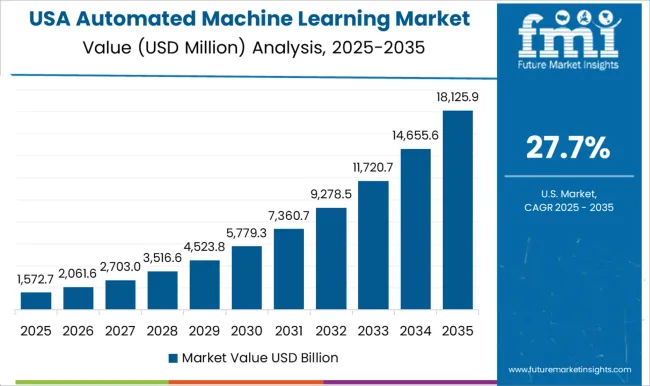
The United States automated machine learning is anticipated to gain a CAGR of 45% through 2035. Factors that are bolstering the growth are:
The market in the United Kingdom is expected to expand with a 46.1% CAGR through 2035. The factors pushing the growth are:
The automated machine learning ecosystem in China is anticipated to develop with a 45.4% CAGR from 2025 to 2035. The drivers behind this growth are:
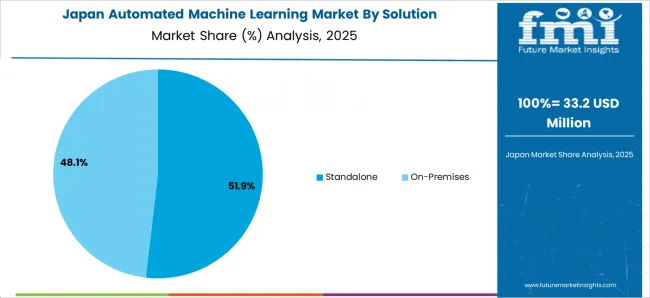
The automated machine learning industry in Japan is anticipated to reach a 46% CAGR from 2025 to 2035. The drivers propelling growth forward are:
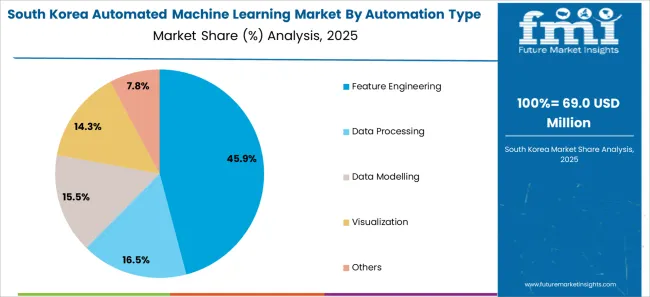
The automated machine learning ecosystem in South Korea is likely to attain a 47.2% CAGR during the forecast period. The factors bolstering the growth are:
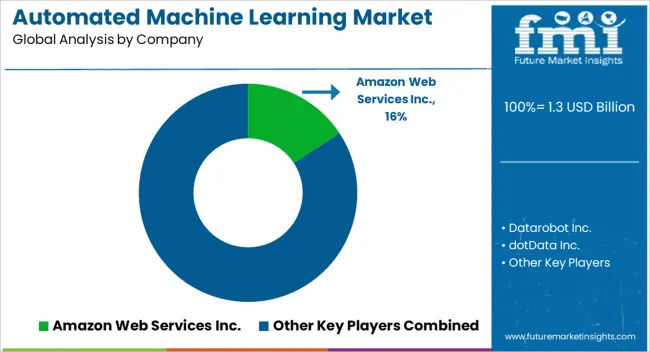
Companies are concentrating on creating platforms and solutions to democratize and simplify the machine learning process in the global automated machine learning market. Their goal is to enable companies with less data science experience to take full advantage of artificial intelligence (AI). These companies provide tools for automating a range of processes, including as feature engineering, model selection, hyperparameter tweaking, and data preparation.
They provide services to a range of sectors, including manufacturing, healthcare, retail, and finance, allowing them to effectively gather insights and make data-driven choices. These companies offer adaptable solutions designed to meet particular company requirements, placing a strong emphasis on user-friendly interfaces and reliable performance to increase accessibility and adoption. The key players in this market include:
Significant advancements in the automated machine learning sector are being made by key market participants, and these include:
| Report Attribute | Details |
|---|---|
| Growth Rate | CAGR of 44.9% from 2025 to 2035 |
| Market value in 2025 | USD 1 billion |
| Market value in 2035 | USD 42.2 billion |
| Base Year for Estimation | 2025 |
| Historical Data | 2020 to 2025 |
| Forecast Period | 2025 to 2035 |
| Quantitative Units | USD billion for value |
| Report Coverage | Revenue Forecast, Company Ranking, Competitive Landscape, Growth Factors, Trends, and Pricing Analysis |
| Segments Covered | Solution, Automation Type, End User, Region |
| Regions Covered | North America; Latin America; Western Europe; Eastern Europe; South Asia and Pacific; East Asia; The Middle East & Africa |
| Countries Profiled | The United States, Canada, Brazil, Mexico, Germany, The United Kingdom, France, Spain, Italy, Poland, Russia, Czech Republic, Romania, India, Bangladesh, Australia, New Zealand, China, Japan, South Korea, GCC Countries, South Africa, Israel |
| Key Companies Profiled | Datarobot Inc.; Amazon Web Services Inc.; dotData Inc.; IBM Corporation; Dataiku; SAS Institute Inc.; Microsoft Corporation; Google LLC; H2O.ai; Aible Inc. |
| Customization Scope | Available on Request |
The global automated machine learning market is estimated to be valued at USD 1.3 billion in 2025.
The market size for the automated machine learning market is projected to reach USD 22.3 billion by 2035.
The automated machine learning market is expected to grow at a 32.6% CAGR between 2025 and 2035.
The key product types in automated machine learning market are standalone and on-premises.
In terms of automation type, feature engineering segment to command 44.5% share in the automated machine learning market in 2025.






Full Research Suite comprises of:
Market outlook & trends analysis
Interviews & case studies
Strategic recommendations
Vendor profiles & capabilities analysis
5-year forecasts
8 regions and 60+ country-level data splits
Market segment data splits
12 months of continuous data updates
DELIVERED AS:
PDF EXCEL ONLINE
Automated Test Equipment Market Size and Share Forecast Outlook 2025 to 2035
Automated CPR Device Market Size and Share Forecast Outlook 2025 to 2035
Automated Compound Storage and Retrieval (ACSR) Market Size and Share Forecast Outlook 2025 to 2035
Automated People Mover Market Size and Share Forecast Outlook 2025 to 2035
Automated Colony Picking Systems Market Size and Share Forecast Outlook 2025 to 2035
Automated Truck Loading System Market Size and Share Forecast Outlook 2025 to 2035
Automated Microplate Handling Systems Market Size and Share Forecast Outlook 2025 to 2035
Automated Solid Phase Extraction Systems Market Size and Share Forecast Outlook 2025 to 2035
Automated Infrastructure Management Solution Market Size and Share Forecast Outlook 2025 to 2035
Automated Mineralogy Solution Market Size and Share Forecast Outlook 2025 to 2035
Automated Material Handling Equipment Market Size and Share Forecast Outlook 2025 to 2035
Automated Feeding Systems Market Size and Share Forecast Outlook 2025 to 2035
Automated Solar Panel Cleaning Market Size and Share Forecast Outlook 2025 to 2035
Automated Molecular Diagnostics Testing System Market Size and Share Forecast Outlook 2025 to 2035
Automated Infrastructure Management (AIM) Solutions Market Size and Share Forecast Outlook 2025 to 2035
Automated Window Blinds Market Size and Share Forecast Outlook 2025 to 2035
Automated Cell Culture Systems Market Analysis - Size, Share & Forecast 2025-2035
Automated Cell Biology Systems Market Size and Share Forecast Outlook 2025 to 2035
Automated Fingerprint Identification System (AFIS) Market Size and Share Forecast Outlook 2025 to 2035
Automated Cannabis Testing Market Size and Share Forecast Outlook 2025 to 2035

Thank you!
You will receive an email from our Business Development Manager. Please be sure to check your SPAM/JUNK folder too.
Chat With
MaRIA